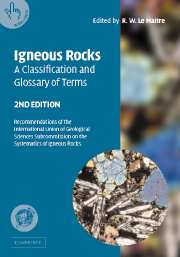 Igneous Rocks: A Classification and Glossary of Terms
Igneous Rocks: A Classification and Glossary of Terms Book contents
- Frontmatter
- Contents
- Figures
- Tables
- Albert Streckeisen
- Foreword to 1st edition
- Chairman's Preface
- Editor's Preface
- 1 Introduction
- 2 Classification and nomenclature
- 3 Glossary of terms
- 4 Bibliography of terms
- Appendix A Lists of participants
- Appendix B Recommended IUGS names
- Appendix C IUGSTAS software package
Foreword to 1st edition
Published online by Cambridge University Press: 01 September 2010
- Frontmatter
- Contents
- Figures
- Tables
- Albert Streckeisen
- Foreword to 1st edition
- Chairman's Preface
- Editor's Preface
- 1 Introduction
- 2 Classification and nomenclature
- 3 Glossary of terms
- 4 Bibliography of terms
- Appendix A Lists of participants
- Appendix B Recommended IUGS names
- Appendix C IUGSTAS software package
Summary
In the early summer of 1958 Ernst Niggli asked Theo Hügi and me if we would be willing to collaborate in revising Paul Niggli's wellknown book Tabellen zur Petrographie und zum Gesteinsbestimmen which had been used as a text for decades at the Federal Polytechnical Institute of Zürich. We agreed and I was placed in charge of the classification and nomenclature of igneous rocks. Quite soon I felt that the scheme used in the Niggli Tables needed careful revision but, as maybe 12 other classification schemes had already been published, Eduard Wenk warned that we should not propose an ominous 13th one; instead he proposed that it would be better to outline the inherent problems of igneous rock classification in an international review article and should present a provisional proposal, asking for comments and replies. This was dangerous advice!
However, the article was written (Streckeisen, 1964), and the consequence was an avalanche of replies, mostly consenting, and many of them with useful suggestions. It thus became clear that the topic was of international interest and that we had to continue. A short report (Streckeisen, 1965) summarized the results of the inquiry. Subsequent discussions with colleagues from various countries led to a detailed proposal (Streckeisen, 1967), which was widely distributed. This was accompanied by a letter from Professor T.F.W. Barth, President of the International Union of Geological Sciences (IUGS), who emphasized the interest in the undertaking, and asked for comments.
Information
- Type
- Chapter
- Information
- Igneous Rocks: A Classification and Glossary of TermsRecommendations of the International Union of Geological Sciences Subcommission on the Systematics of Igneous Rocks, pp. x - xiiPublisher: Cambridge University PressPrint publication year: 2002